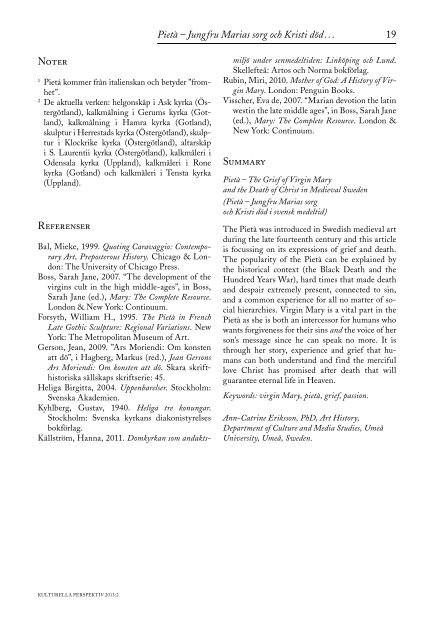149676_kulturell-perspektiv-nr-2-13
149676_kulturell-perspektiv-nr-2-13
149676_kulturell-perspektiv-nr-2-13
You also want an ePaper? Increase the reach of your titles
YUMPU automatically turns print PDFs into web optimized ePapers that Google loves.
Pietà – Jungfru Marias sorg och Kristi död . . .<br />
19<br />
Noter<br />
1<br />
Pietá kommer från italienskan och betyder ”fromhet”.<br />
2<br />
De aktuella verken: helgonskåp i Ask kyrka (Östergötland),<br />
kalkmålning i Gerums kyrka (Gotland),<br />
kalkmålning i Hamra kyrka (Gotland),<br />
skulptur i Herrestads kyrka (Östergötland), skulptur<br />
i Klockrike kyrka (Östergötland), altarskåp<br />
i S. Laurentii kyrka (Östergötland), kalkmåleri i<br />
Odensala kyrka (Uppland), kalkmåleri i Rone<br />
kyrka (Gotland) och kalkmåleri i Tensta kyrka<br />
(Uppland).<br />
Referenser<br />
Bal, Mieke, 1999. Quoting Caravaggio: Contemporary<br />
Art, Preposterous History. Chicago & London:<br />
The University of Chicago Press.<br />
Boss, Sarah Jane, 2007. “The development of the<br />
virgins cult in the high middle-ages”, in Boss,<br />
Sarah Jane (ed.), Mary: The Complete Resource.<br />
London & New York: Continuum.<br />
Forsyth, William H., 1995. The Pietà in French<br />
Late Gothic Sculpture: Regional Variations. New<br />
York: The Metropolitan Museum of Art.<br />
Gerson, Jean, 2009. ”Ars Moriendi: Om konsten<br />
att dö”, i Hagberg, Markus (red.), Jean Gersons<br />
Ars Moriendi: Om konsten att dö. Skara skrifthistoriska<br />
sällskaps skriftserie: 45.<br />
Heliga Birgitta, 2004. Uppenbarelser. Stockholm:<br />
Svenska Akademien.<br />
Kyhlberg, Gustav, 1940. Heliga tre konungar.<br />
Stockholm: Svenska kyrkans diakonistyrelses<br />
bokförlag.<br />
Källström, Hanna, 2011. Domkyrkan som andaktsmiljö<br />
under senmedeltiden: Linköping och Lund.<br />
Skellefteå: Artos och Norma bokförlag.<br />
Rubin, Miri, 2010. Mother of God: A History of Virgin<br />
Mary. London: Penguin Books.<br />
Visscher, Eva de, 2007. “Marian devotion the latin<br />
westin the late middle ages”, in Boss, Sarah Jane<br />
(ed.), Mary: The Complete Resource. London &<br />
New York: Continuum.<br />
Summary<br />
Pietà – The Grief of Virgin Mary<br />
and the Death of Christ in Medieval Sweden<br />
(Pietà – Jungfru Marias sorg<br />
och Kristi död i svensk medeltid)<br />
The Pietà was introduced in Swedish medieval art<br />
during the late fourteenth century and this article<br />
is focussing on its expressions of grief and death.<br />
The popularity of the Pietà can be explained by<br />
the historical context (the Black Death and the<br />
Hundred Years War), hard times that made death<br />
and despair extremely present, connected to sin,<br />
and a common experience for all no matter of social<br />
hierarchies. Virgin Mary is a vital part in the<br />
Pietà as she is both an intercessor for humans who<br />
wants forgiveness for their sins and the voice of her<br />
son’s message since he can speak no more. It is<br />
through her story, experience and grief that humans<br />
can both understand and find the merciful<br />
love Christ has promised after death that will<br />
guarantee eternal life in Heaven.<br />
Keywords: virgin Mary, pietà, grief, passion.<br />
Ann-Catrine Eriksson, PhD, Art History,<br />
Department of Culture and Media Studies, Umeå<br />
University, Umeå, Sweden.<br />
KULTURELLA PERSPEKTIV 20<strong>13</strong>:2


